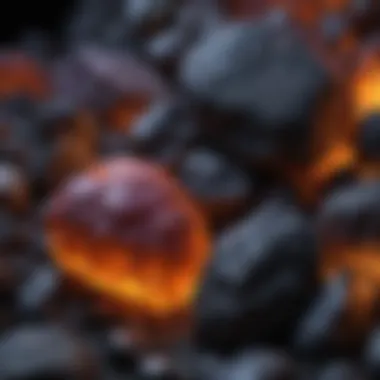Exploring Black Light's Effectiveness in Cleaning


Intro
In recent years, black light technology has gained recognition in the cleaning sector, especially among rock and fossil collectors. This examination highlights how black lights expose hidden contaminants that are otherwise invisible to the naked eye. Key features of this technology include its advantages and applications, particularly those benefiting hobbyists eager to enhance their preservation techniques.
Rock and Fossil Identification
Identifying rocks and fossils requires understanding various types and physical characteristics. Many laypeople might overlook subtle hints in a specimen's structure. Black light shines a light on aspects often missed, facilitating enhanced identification processes.
Types of Rocks and Fossils
Different rock and fossil types need distinct identificationiztion methods. Here is a simple categorization:
- Igneous Rocks: Formed from volcanic activity and possess a crystalline structure. For example, basalt and granite.
- Sedimentary Rocks: Created from deposition and compression of minerals and organic materials. Sandstone is a common type.
- Metamorphic Rocks: Formed under extreme pressure, altering the original material, such as schist or marble.
- Fossils: Organisms preserved within rock over geological time, like trilobites and ammonites.
Characteristics to Look For
When identifying specimens under black light, several key features become visible or change:
- Fluorescence: Certain minerals become visible, often glowing vibrantly under UV light.
- Texture: Differentials in roughness or lumps can indicate organic presence.
- Color Changes: Some fossils reveal unique coloration patterns that traditional lights might not expose.
Tools for Identification
Utilizing proper tools can enhance the identification process under black light:
- Black Light Lamp: UV varieties specifically designed for detection.
- Magnifying Glasses: Allow for closer inspection of details.
- Cleaning Brushes: Keep specimens free from dirt to enhance visibility.
Collecting Tips and Techniques
Collecting rocks and fossils is an engaging pursuit. Efficient and safe techniques will improve your collections.
Best Practices for Collecting
- Go prepared with the right tools: have sturdy bags, tools for extraction, and notebooks for documentation.
- Respect guidelines and legal restrictions in collecting locations. Some parks restrict removal of specimens.
- Always document the find's location and condition.
Locating Prime Collecting Sites
Potential spots for rich fossil hunting include:
- Riverbanks where erosion uncovers historical layers.
- Lands familiar for geological formations, such as limestone outcrops.
- Former quarry sites known for their robust deposits.
How to Safely Extract Specimens
Safer techniques during extraction may include:
- Use tools to dig, rather than removing artifacts manually.
- Bring backups for equipment in case of breakage.
- Clearly understand the matrix you are excavating to avoid damage.
Preservation and Display
Once you've collected fossils, preservation becomes crucial.
Techniques for Preserving Rocks and Fossils
Enhanced preservation under black light can prolong their life:
- Sealing: Use chemical sealants respectful of the specimen's form.
- Clean: Gently clean to remove contaminants, ensuring thorough drying.
Proper Storage Methods
Adequate storage prevents deterioration:
- Store in acid-free containers.
- Maintain stable temperature and humidity to avoid cracking or warping.
Creative Display Ideas
Displaying your specimens maximally highlights their beauty. Black lights can enhance such displays:
- Use shadow boxes with neon-colored foam backgrounds for contrast.
- Consider rotating them periodically to prevent prolonged exposure to UV light.


Geological Insights
Understanding geological context assists collectors in appreciating their collections more profoundly.
Geological Formations and Processes
Collecting insights regarding formation types may lead to enhanced appreciation of fossil variations:
- Formations: Think about the origin of materials, from sediment than can can later be cemented into rock.
Historical Significance of Rocks and Fossils
Researching notable essences can add depth to what's seen:
- How specifics change perceptions of Earth's history through fossils, revealing paleo-climate and evolutionary changes.
Notable Discoveries in the Field
Following discoveries assists in generating interest among collectors:
- Certain remark-worthy find scenarios offer fascinating backgrounds, like fossils uncovered during construction. Sharing such stories can spur excitement within the community.
In summary, black light technology serves not only as a cleaning tool but a vital instrument for rock and fossil identifications, inviting enthusiasts to explore their collections more fully.
Intro to Black Light Technology
Black light technology represents a pivotal advancement in cleaning techniques, significantly enhancing the ability to detect and eliminate hidden contaminants. The significance of this topic lies in how ultraviolet (UV) light provides not only visibility beyond the normal spectrum but also contributes to more effective cleaning protocols in a range of environments, including residential spaces and industrial settings. With its applications verified through clarity, proficiency, and innovation, integrating black light technology can lead to improved hygiene standards that surpass traditional methods.
Understanding Ultraviolet Light
Ultraviolet light encompasses a section of the electromagnetic spectrum, falling between visible light and X-rays. Its wavelengths range from approximately 10 to 400 nanometers. In practical terms, UV light offers specialist advantages for cleaning. Commonly separated into three categories: UVA, UVB, and UVC, each type has a unique application. UVC is often utilized for disinfection, therefore presenting important opportunities for cleaning in medical and industrial alignments, ensuring that harmful pathogens can be neutralized. Black lights primarily use UVA radiation, effective for identifying certain types of organic materials, specifically body fluids, which tend to fluoresce under specific conditions.
History and Development of Black Light
The development of black light technology spans several decades, with its origins tracing back to the early 20th century when scientists began recognizing applications for ultraviolet light. Initial usage mainly focused on lamp technology aimed at improved visibility in varied situations, expanding first to the entertainment industry and subsequently flowing into fields requiring advanced cleaning solutions.
In the mid-20th century, researchers observed the significant effectiveness of UV light in eliminating bacteria and viruses, thus stimulating widespread interest across diverse sectors such as healthcare and hospitality. As technology advanced, the design and efficiency of these ultraviolet lamps improved substantially. Equipment now includes sleek, powerful and portable devices, allowing wider accessibility for consumers, especially those keen on resource allocation in rock and fossil collections. The evolution of black light technology is rooted in an enhancing understanding of light's physical properties, as well as its applications across multiple scientific domains.
Mechanism of Action in Cleaning
The use of black light technology in cleaning transcends mere visibility enhancements. Understanding the mechanisms behind its action is fundamental for appreciating the technique's broad relevance across various cleaning contexts. This section will detail the specific elements and benefits stemming from its complex interactions with diverse contaminants.
Fluorescence and Its Implications
Fluorescence forms the cornerstone of how black light technology operates. Ultraviolet (UV) light emitted from black lights interacts with certain materials, causing them to emit visible light. This emission is particularly significant when it pertains to cleaning practices, as many organic substances react strongly to UV light.
Fluorescent substances often include bodily fluids, food residues, and a range of other organic materials that are typically invisible to the naked eye. The specific wavelengths of light emitted by a black light excite these materials, transforming them into a glow that highlights their presence on various surfaces. This mechanism is beneficial in detecting contaminants quickly and efficiently, significantly reducing the time spent on identifying cleaning areas.
Moreover, this fluorescence provides additional insight into the nature of pollutants or stains present. For instance, differentiating between types of residues can aid in selecting suitable cleaning methods tailored to address specific contaminants. This targeted approach promotes cleanliness more effectively, saving time and resources that might otherwise be misallocated.
Identifying Organic and Inorganic Contaminants
In the realm of cleaning, detection of various contaminants is pivotal. Black light technology doesn't merely target visible residues; it enhances the discernment of both organic and inorganic entities.
Organic Contaminants
Common organic contaminants detectable by black light include substances like bodily fluids, food spills, and even certain types of pest excrement. These materials often fluoresce under UV light, revealing areas of concern that would remain hidden without such technology. By facilitating early detection, black light helps in the prevention of potential health hazards that could arise from unaddressed pollution, particularly in environments with high human activity.
Inorganic Contaminants
In addition, some inorganic materials can also reflect UV light. For example, cleaning agents and industrial preservatives may display specific fluorescent patterns, signaling the need for reconsideration of their application. By distinguishing between organic and inorganic contributions to contamination, researchers and cleaners can develop orch stratagies to tailor cleanup efforts effectively.
Understanding the dual ability of black light to highlight both organic and inorganic contaminants provides critical insight for parties invested in both domestic and industrial cleaning.
Utilizing black light in identifying residues extends far beyond aesthetic enhancement. The capability to reveal obscure stains or contaminants serves well in laboratories, hospitals, and other spaces where cleanliness is paramount. It strengthens the overarching goal of safe, effective cleaning, while also paving the way for future developments in cleaning methodologies and technologies.
Applications of Black Light in Various Environments


Black light technology has found its way into various domains for its potential to enhance cleaning operations. The principle revolves around the capacity of black light to make invisible contaminations visible. This technology, aimed at identifying organic and inorganic substances is essential for precise cleaning efforts.
Residential Cleaning
In residential contexts, black light is periodically underutilized for general household cleaning. However, its benefits are significant. One major application is in pet ownership. Pet stains, including urine and vomit, are often challenging to detect with regular cleaning tools. Black light addresses this issue by illuminating organic materials, allowing homeowners to target specific areas effectively.
Using black light enables homeowners to ensure thorough cleaning, ultimately promoting a healthier environment. Residents should invest in portable black lights to facilitate an easier lifestyle. Basic operation involves shining the light upon surfaces; any spots that glow indicate areas requiring additional cleaning. Educating residents about these devices aligns with public health goals, reinforcing the idea that cleaner homes contribute significantly to overall well-being.
Industrial Settings
In the industrial sector, especially within food processing or manufacturing, cleanliness is paramount not only for quality but also for safety. Black light plays a crucial role in adhering to stringent cleanliness standards that reflect on operational efficiency.
Within such contexts, surfaces can harbor contaminants unseen to the naked eye, raising risks that could result in severe consequences. Teams can deploy specialized black light systems to conduct routine inspections, ensuring persistent cleanliness of production areas, machinery, and employee environments. This preventative strategy minimizes downtime, reduces product waste, and sustains corporate accountability.
- Enhanced detection of residue or bacterial content allows preparations for targeted cleaning.
- Financial investment in these technologies can be offset through reduced pest control costs and improved compliance with health regulations.
Laboratories and Medical Facilities
Black light technology shapes disinfection protocols within laboratories and medical facilities. Environments that demand high standards of sterility benefit from the identification of contamination. Innovative laboratories often incorporate black lights in inspection routines.
The application includes visibility enhancements in surgical rooms and laboratories that analyze samples. Previously invisible fluids can now be pinpointed efficiently. Thus clearer identification can reinforce reactions to contamination and enable teams to implement necessary cleaning measures swiftly.
Most importantly, laboratory staff gain confidence in their environment's cleanliness as they integrate outcomes from black light surveillance into brushing up their infection-control strategies.
- Precise clean-up follows finding hazards, enhancing overall facility functions.
- Training staff to adapt to this technology amplifies compliance with evolving sanitary regulations.
Benefits of Using Black Light for Cleaning
The utilization of black light technology in cleaning processes merits substantial attention due to its unique capabilities. This section considers several specific advantages of black light in identifying contaminants and enhancing cleaning efficiency. Understanding these benefits illuminates why rock and fossil collectors, alongside other professionals, can significantly enhance their cleaning methods using such technology.
Enhanced Visibility of Contamination
Black light technology is invaluable for exposing hidden contaminants that standard lighting often overlooks. Many organic materials and certain substances emit fluorescence when exposed to ultraviolet light. Such materials include oils, proteins, and even some pigments.
When a surface is illuminated with a black light,* traditional cleaning methods may fail to highlight residues, while black light reveals clearly. This assures that collectors can examine their specimens without the concern of negligence regarding unseen dirt or oils.
As bacteria often reflect differently under UV rays, this illumination aids in locating potential contaminants, enhancing the quality of items. Cleaning efforts can thus be focused on exact areas rather than assuming these processes are comprehensive.
To enumerate some specific elements:
- The detection of organic compounds, oils, and fluids on surfaces
- Identification of mineral specimens with unique fluorescence property via UV exposure
- The improvement of the effectiveness in sifting through material for rock and fossil preparation
Efficiency in Targeted Cleaning
When collectors utilize black light, they notice an improved precision in their cleaning strategies. Traditional techniques may initiate a span of general cleaning—it allows for an more general search. However, with a black light, targeted cleaning focuses attention on precisely-defined areas.
This efficiency saves both time and effort. Decluttering becomes streamlined, allowing collectors to prioritize where it's most needed. As a result, they do not waste energy cleaning parts that do not require extensive intervention. Moreover, specimens are less likely to incur damage from repeated cleaning that does not target problem areas directly. Efficient cleaning can considerably prolong the lifespan and aesthetic integrity of specimens, a crucial aspect for collectors.
Reduction of Chemical Use
Another pivotal benefit of using black light technology is the potential reduction of chemical dependency in the cleaning process. Otherwise necessary chemical agents frequently pose hazards to human health and can adversely impact the environment—more so in contexts involving delicate geological specimens.
Primarily focused on identifying contaminants.Black light eliminates the reliance on some harsh agents. A more straightforward identification method makes it possible to approach cleaner processes, reducing dual cleaning phases often necessitated with standard chemicals. When contaminants are revealed, effective cleaning can happen with water or mild soap rather than potent chemicals.
Of significance is:
- Obtaining a cleaner outcome efficiently without dangerous products
- Significantly lowering fixative or preservation chemical usage
- Integrating a more eco-friendly approach toward mineral specimen collection
These benefits underline just how black light technology can profoundly impact cleaning processes. Its capability to reveal, target, and reduce contaminative risk speaks plainly to its efficacy, ushering in new opportunities for collectors in various niches.
In summary, the use of black light during cleaning does not simply clarify hidden aspects. It optimizes techniques, facilitates cleaner environments, and broadens potential high-quality outcomes for collectors.
Black Light in the Context of Collecting Rocks and Fossils
The use of black light technology extends its benefits beyond traditional cleaning contexts and finds significant utility within rock and fossil collecting. As collectors often seek unique specimens, the ability to employ black light offers them a specialized tool for identifying features incompatible under normal light conditions. By delineating mineral differences and characteristics, black lights enhance the collector's experience and broaden their understanding of their finds.
Identifying Mineral Specimens


When collectors search for rocks and fossils, it is crucial to accurately identify the mineral contents and their properties. Black light aids in this process by making certain minerals fluoresce. For instance, calcite and willemite glow under specific ultraviolet wavelengths, prompting collectors to differentiate among similar-looking specimens. This reaction can assist in not only identifying but also categorizing given minerals effectively. Others, such as fluorite, can show various colors under different lights, unveiling hidden aspects of the specimen.
Using black lights can help collectors save time. When comparing various specimens, previously obscured differences become apparent. This clear visibility can minimize errors and contribute to better choices. Contrast new finds with previously collected materials using black light evaluations to discern potential value.
Preservation Techniques
Employing black light is not limited solely to identification; it also enhances preservation techniques for collectors worried about maintaining the integrity of their specimens. Dust, grime, or biological contaminants can weaken or damage fossils over time, necessitating careful cleaning methods. Traditional cleaning methods may inadvertently harm delicate minerals or fossils, but black light signals areas needing attention without disturbing the specimen's actual surface.
Techniques using black light involve carefully targeting areas of interest, permitting gentle cleaning using soft brushes or cloths. Following this inspection, collectors can use methanol or hydrogen peroxide for light cleansing, treating recognizably stained points without compounding damage.
Additionally, black light helps assess the condition of fossils. Aging, deterioration, or other issues may be discerned early with the use of this technology, allowing collectors to take preventive measures. Preservation reactions may become more prominent under examination, revealing reactions that necessitate routine care and management. Ensuring effective cleaning methods lead to a longer lifespan for cherished mineral and fossil specimens.
Black light technology immensely improves the ability to identify and preserve mineral specimens, offering collectors advanced insight into their selections and care options. Ultimately, one clear benefit is that minimal compromises to specimen integrity occur during scrutiny.
In summation, black light not only supports identifying unique mineral aspects but also plays a strategic role in their preservation. Rock and fossil collectors benefit from the enhanced capacity it provides in distinguishing features and the careful upkeep of their refinement, thus increasing their overall appreciation for their collections.
Safety Considerations with Black Light Usage
Black light technology has gained significant traction in various fields, particularly in cleaning. However, as with any technological application, there are imperative safety considerations to think about. Understanding these precautions not only helps to safeguard individuals but also ensures optimal efficacy of the cleaning process utilizing black light.
Protective Measures
When working with black lights, adopting protective measures is essential to minimize risks. This technology emits ultraviolet (UV) radiation, which can pose various dangers if proper precautions are sidelined. Here are some recommended practices that should be part of any user's routine:
- Use Personal Protective Equipment (PPE): Wear UV-blocking goggles to protect the eyes from direct UV exposure. Although black lights primarily exist in the 'A' spectrum of UV radiation, prolonged exposure can nonetheless cause discomfort or harm.
- Limit Time of Exposure: Engage with black light in moderation. The less time spent under the UV light, the lower the risk of potential skin damage or other negative effects.
- Work in Well-Ventilated Areas: Ensure the workspace is adequately ventilated. Working in confined spaces can compound the risks associated with prolonged UV exposure.
- Maintain Distance: When possible, keep a safe distance from the black light source to reduce exposure risks.
Implementing these protective measures can ensure that rock and fossil collectors or any user of black light technology remains safe during their cleaning processes.
Understanding UV Exposure Risks
A comprehensive discussion on safety would be incomplete without understanding the risks presented by UV exposure. Ultraviolet light, while useful for identifying contaminants that are invisible to the naked eye, can become a liability if not treated with respect. It affects skin and eyes, presenting threats you should be aware of.
Potential Risks:
- Skin Damage: Prolonged exposure to UV radiation can lead to sunburn-like effects on the skin, increasing the risk of skin cancer in severe cases.
- Eye Damage: UV rays can harm the retina, causing various vision problems. Additionally, conditions like photokeratitis can result from acute UV exposure.
- Worsening Pre-existing Conditions: For individuals with certain conditions, such as photosensitivity, exposure to UV light could exacerbate symptoms.
It is crucial to understand these risks to take informed decisions when using black light technology. Following safety guidelines is not merely an optional step; it is a mandatory aspect that underpins the efficacy of the cleaning processes while assuring user safety.
Always couple safety practices with informed knowledge about the technology being used. A thorough understanding empowers the user to derive maximum benefits from black light cleaning while maintaining their safety and integrity.
Future of Black Light Technology in Cleaning
The evolution of cleaning practices continues, driven by advances in technology. The future of black light technology in cleaning holds significant potential. Black light can help in identifying unseen contaminants, cleaning deeper, and using fewer harsh chemicals. Therefore, understanding and embracing its future becomes essential for collectors and cleaning professionals alike.
Innovations in Design and Functionality
The design and functionality of black light devices are currently undergoing transformations.
- Portable Design: New models are more compact and lightweight, allowing users to carry them effortlessly. This aspect is critical for rock and fossil collectors who may need portable solutions while out in the field or on the go.
- Improved Filter Systems: Some devices now come with enhanced filter systems, increasing the specificity of detection while decreasing interference from ambient light.
- Dual-purpose Facilities: Future innovations could lead to designs that integrate features for both direct cleaning assumptions and research, assisting in the ongoing study of organic and inorganic materials.
These advances not only broaden the usability of black light but also optimize the outcomes, promoting more efficient cleaning practices while attending to the particular needs of the target audiences.
Integration with Other Cleaning Technologies
The integration of black light technology with other cleaning methods can represent a major step cleanign. Employing a multi-faceted approach ensures thorough sanitation in diverse cleaning contexts.
- Ultrasonic Cleaning: By partnering black light with ultrasonic cleaning devices, practitioners can detect and eliminate undesired material more effectively. For example, vibrating particles tens of thousands of times per second clean away the contaminations revealed by the black light.
- Chemical-Based Cleaning Agents: Combining black light detection capabilities with green cleaning agents significantly minimizes title toxic exposure while maintaining effective cleanliness, hence becoming more sustainable.
- Automated Systems: Future developments might see black light technology integrated into automated cleaning machines, automating the inspection and cleaning process at high efficiency levels in industry.
By augmenting existing cleaning strategies with black light technology, users can mount a more comprehensive attack on residue, repositioning cleaning practices toward higher cleanliness standards, while minimizing health risks due to chemical involvement.
Integrating black light technology with varying techniques in cleaning informs improved practices across both educational and professional channels.
The continuously evolving field promises a longer trajectory for efficiency, discovery, and innovation in every aspect of cleaning. Collectors can expect advancements that will not just enhance cleaning efficacy but also foster an awareness of their cleaning methods impacts.
Closure
The topic of black light usage in cleaning is significant for several reasons. As explored in the article, black light technology offers a unique advantage in identifying hidden contaminants that may not be visible to the naked eye. This capability is especially important in environments that require thorough cleanliness, such as medical facilities, laboratories, and residential spaces.
Summary of Key Points
Black light technology operates on principles of ultraviolet light and fluorescence. The key advantages identified include the enhanced visibility of contaminants, improved targeted cleaning methods, and reduced reliance on traditional chemical cleaning products. These factors contribute to a safer and more efficient cleaning process.
Final Thoughts on Black Light for Cleaning
Adopting black light technology is a step forward in cleaning practices. For rock and fossil collectors, it can reveal details about specimens that remains hidden under regular light. Investiging this tool can improve cleaning methods significantly, which means better preservation of these natural wonders. Embracing this technology not only enhances cleaning but sets a standard of quality in inspection and care both in collections and everyday environments. As black light evolves, its capabilities will adapt and improve, making it more essential.
"Black light reveals a hidden world, transforming our approach to cleanliness and preservation."
Utilizing black light can lead to healthier living spaces and more thriving collections. The advance of cleaning technology into the realm of ultraviolet light holds promise for the future, inviting continual exploration of its functionalities and implications.







